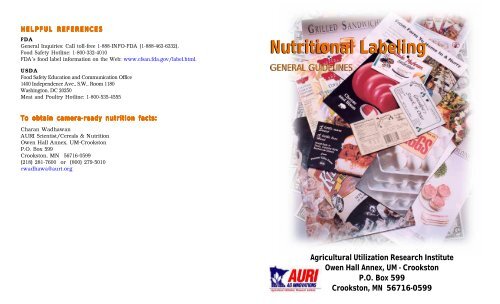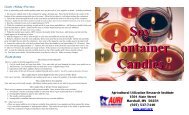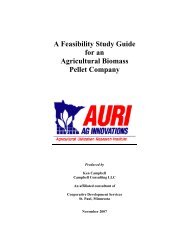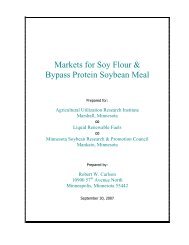Nutritional Labeling Nutritional Labeling - AURI
Nutritional Labeling Nutritional Labeling - AURI
Nutritional Labeling Nutritional Labeling - AURI
Create successful ePaper yourself
Turn your PDF publications into a flip-book with our unique Google optimized e-Paper software.
HELPFUL REFERENCESFDAGeneral Inquiries: Call toll-free 1-888-INFO-FDA (1-888-463-6332).Food Safety Hotline: 1-800-332-4010FDA’s food label information on the Web: www.cfsan.fda.gov/label.html.USDAFood Safety Education and Communication Office1400 Independence Ave., S.W., Room 1180Washington, DC 20250Meat and Poultry Hotline: 1-800-535-4555<strong>Nutritional</strong> <strong>Labeling</strong>GENERAL GUIDELINESTo obtain camera-ready nutrition facts:Charan Wadhawan<strong>AURI</strong> Scientist/Cereals & NutritionOwen Hall Annex, UM-CrookstonP.O. Box 599Crookston, MN 56716-0599(218) 281-7600 or (800) 279-5010cwadhawa@auri.orgAgricultural Utilization Research InstituteOwen Hall Annex, UM - CrookstonP.O. Box 599Crookston, MN 56716-0599
The term “light” still can be used to describe such properties as texture and color, as long asthe label explains the intent—for example,“light brown sugar” and “light and fluffy.”MoreThis term means that a serving of foodwhether altered or not, contains a nutrientthat is at least 10 percent of the Daily Valuemore than the reference food. The 10 percentof Daily Value also applies to “fortified,”“enriched” and “added” “extra and plus”claims, but in those cases, the food must bealtered.Alternative spelling of these descriptive termsand their synonyms is allowed—for example,“hi” and “lo”—as long as the alternatives arenot misleading.HealthyA “healthy” food must be low in fat and saturated fat and contain limited amounts ofcholesterol and sodium. In addition, if it’ s a single-item food, it must provide at least 10percent of one or more of vitamins A or C, iron, calcium, protein, orfiber. Exempt from this “10-percent” rule are certain raw, cannedand frozen fruits and vegetables and certain cereal-grain products.These foods can be labeled “healthy,” if they do not containingredients that change the nutritional profile, and, in the case ofenriched grain products, conform to standards of identity, which callfor certain required ingredients. If it’s a meal-type product, such asfrozen entrees and multi-course frozen dinners, it must provide 10percent of two or three of these vitamins or minerals or of protein orfiber, in addition to meeting the other criteria. The sodium contentcannot exceed 360 mg per serving for individual foods and 480 mgper serving for meal-type products.HEALTH CLAIMSClaims for 10 relationships between a nutrient or a food and the riskof a disease or health-related condition are now allowed. They can- Total calories- Calories from fat- Total fat- Saturated fat content- Trans Fat- Cholesterol- Sodium- Total Carbohydrates- Dietary Fiber- Sugars- Protein- Vitamin A and C- Calcium- IronVoluntary dietary components that can be listed on the label include calories from saturatedfat, polyunsaturated fat, monounsaturated fat, potassium, soluble fiber, insoluble fiber, sugaralcohol, other carbohydrates, and vitamins and minerals.All nutrients must be stated as a percentage of their “Daily Value” to show how much of a day’sideal total of a particular nutrient THE consumer is getting.FORMATSAlthough FDA has permitted a variety offormats to be used for presenting nutritioninformation, the conditions under which eachformat may be used are specified in detail.Depending upon the product and packagesize, the format could be Standard, simplifiedor shortened.SERVING SIZESThe nutrient content information presented inthe Nutrition Facts panel is based on a servingof the food and is intended to help consumerscompare products. FDA has established asystem for determining serving sizes based onamounts normally consumed per eatingoccasion. Regulations for determining theserving size to use on a food label may befound in 21 CFR 101.12(b) and for meat andpoultry products in 9 CFR 317.312Household units – Label serving sizes are to bedeclared in common household units familiarto most consumers. These units are cups,
tablespoons, teaspoons, piece, slice, fraction, ounce, fluid ounce, etc. The common householdmeasure is followed by its metric equivalent in grams (g).NUTRIENT CONTENT CLAIMSNutrient content claims describe the level of nutrient in a food product; also referred to asdescriptors. Food manufacturers are required to use standardized definitions when makingclaims concerning the nutrient contents of foods. These are the core terms:FreeThese products contain no amountof, or only trivial or “physiologicallyinconsequential” amounts of, one ormore of these components: fat,saturated fat, cholesterol, sodium,sugars, and calories. For example,“calorie-free” means fewer than 5calories per serving, and “sugar-free”and “fat-free” both mean less than 0.5g per serving. Synonyms for “free”include “without,” “no” and “zero.”A synonym for fat-free milk is “skim”.LowThese foods may be eaten frequentlywithout exceeding dietary guidelinesfor one or more of these components:fat, saturated fat, cholesterol, sodium,and calories. Thus, descriptors aredefined as follows:! low-fat: 3 g or less per serving! low-saturated fat: 1 g or less per serving! low-sodium: 140 mg or less per serving! very low sodium: 35 mg or less per serving! low-cholesterol: 20 mg or less and 2 g or less of saturated fat per serving! low-calorie: 40 calories or less per serving.Synonyms for low include “little,” “few,” “low source of,” and “contains a small amount of.”Lean and extra leanThese terms describe the fat content of meat, poultry, seafood, and game meats.! lean: less than 10 g fat, 4.5 g or less saturated fat, and less than 95 mg cholesterol perserving and per 100 g.! extra lean: less than 5 g fat, less than 2 g saturated fat, and less than 95 mg cholesterol perserving and per 100 g.HighThis term can be used if the food contains 20 percent or more of the Daily Value for aparticular nutrient in a serving.Good sourceThis term means that one serving of a food contains 10 to 19 percent of the Daily Value for aparticular nutrient.ReducedThis term means that a nutritionally altered product contains at least 25 percent less of anutrient or of calories than the regular, or reference, product. However, a reduced claim can’tbe made on a product if its reference food already meets the requirement for a “low” claim.LessThis foods whether altered or not, contains 25 percentless of a nutrient or of calories than the reference food.For example, pretzels that have 25 percent less fat thanpotato chips could carry a “less” claim. “Fewer” is anacceptable synonym.LightThis descriptor can mean two things:! First, that a nutritionally altered product containsone-third fewer calories or half the fat of thereference food. If the food derives 50 percent ormore of its calories from fat, the reduction mustbe 50 percent of the fat.! Second, that the sodium content of a low-calorie,low-fat food has been reduced by 50 percent. Inaddition, “light in sodium” may be used on food in which the sodium content hasbeen reduced by at least 50 percent.










